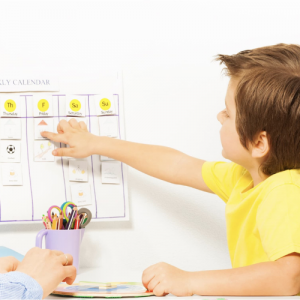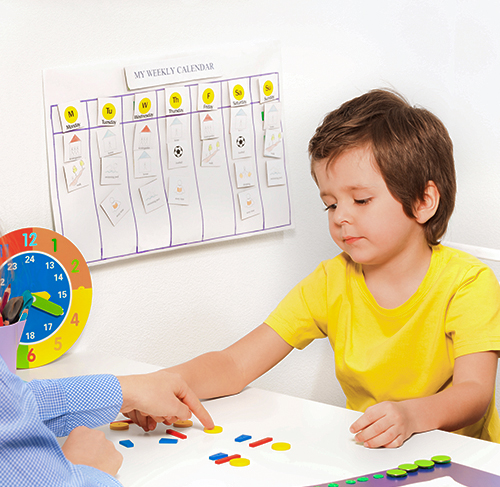Nowadays, there are beautiful fancy software systems that allow us (the providers) to view data collected on each session on a daily basis. Why is this important? Well, data paints a picture of what is happening. It also helps to understand if the child is getting the benefits of ABA therapy. Did a specific behavior decrease, are skill acquisition targets increasing, or did something plateau?
Board Certified Behavior Analysts (BCBAs) analyze data to see if the intervention implemented is working or needs to be adjusted. But how do you, as a parent or caregiver, measure progress? The data is one side of the equation, and even though you always have access to the data, and it is often reviewed during parent training sessions, it should reflect what your day-to-day experiences with your child are like. So, what does that mean? It just means that if the data shows that certain behaviors, let us say tantrums, are decreasing, you should feel this change at home or in whatever other setting you interact with your child.
Maladaptive Behaviors are Decreasing
The core of what we do relies on identifying inappropriate behaviors and their functions to be able to teach socially appropriate behaviors that can lead to obtaining similar results or serve the same function. For example, if your child hits you every time you engage in play activity with a sibling. We might interpret that this behavior is due to wanting attention from you as his or her parent. In this case, we would teach your child that instead of hitting, he or he could request attention by gesturing, signing, or vocally asking you to play. As your child learns to master these skills, everyday interactions should feel easier, and your ability as a parent to redirect your child to the appropriate behavior should come more naturally.
Communication is Increasing
One of the biggest components of an ABA treatment plan is focused on communication skills. This can include any type of communication. Communication can be done by signing, gesturing, using pictures, an AAC device, or vocal communication. We often see that the inability to properly communicate wants and needs elicits plenty of maladaptive behaviors. We incorporated goals related to communication, such as requesting and labeling to decrease these. After a few months of treatment, you should be able to see an increase in your child’s ability to express wants and needs.
Building Social and Communication Skills
ABA does more than help a child ask for what they need. It also builds socialization communication and expressive language skills. These are the tools children need to connect with family, teachers, and friends.
For example, an ABA program may teach a child how to take turns during play, greet a classmate, or share toys. Over time, these skills give the child more chances to join group activities. For many children with autism spectrum disorder ASD, learning these small steps makes everyday life feel more positive and less stressful.
Activities of Daily Living
Growing the desire to have more independence of your children and do things on their own usually grows with them. Yet, for some children with different exceptionalities, independently engaging in these activities could be a struggle; due to an array of reasons, such as poor motor planning, difficulty with fine motor skills, etcetera. This frustration can often lead to maladaptive behaviors. As treatment is implemented, the consistency of practicing all these activities of daily living will help increase your child’s independence. Additionally, working through the frustration and allowing your child to express themselves in a more socially appropriate manner, such as, vocally requesting for help or gesturing, will allow you to know when your child requires your assistance, preventing further frustration and avoiding some of those maladaptive behaviors.
More Everyday Benefits You Might Notice
ABA therapy can touch many parts of daily life, not just behavior. Families often see progress in areas like:
- School readiness: Children practice skills such as following directions, sitting for short periods, and paying attention. These small steps make the transition to classroom routines smoother.
- Emotional regulation: ABA teaches coping tools for frustration, waiting, and changes in routine. Parents often notice fewer meltdowns and more calm responses.
- Safety skills: Children may learn to stop at the curb, respond when their name is called, or hold a parent’s hand in busy places. These skills give families peace of mind.
- Generalization: Skills taught during sessions are practiced at home, school, and in the community. This makes sure the child can use what they’ve learned in everyday life.
- Parent-child connection: Parent training in ABA gives families strategies to handle tough moments. As behavior improves, time together becomes more positive and enjoyable.
Generalization in the Data
One of the biggest signs of progress in ABA therapy is generalization. This means your child is not only showing new skills in therapy sessions but also using them at home, in school, or in the community. Generalization is a powerful indicator that learning is sticking.
For example, your child may first learn to request a toy during therapy. Later, you might see the same skill when they ask for a favorite snack at home. The therapy team may track this as the skill appearing in multiple environments. For parents, this means real change you can see in daily routines—not just in the clinic.
Why Parent Feedback Matters
Data collection is powerful, but it doesn’t tell the whole story on its own. Parents play an important role in filling the gaps. What happens outside therapy sessions matters just as much as what happens inside them.
If you notice your child using new words during dinner or showing fewer meltdowns at bedtime, sharing that with your BCBA makes a difference. Your feedback adds context to the data, helping the therapy team see the bigger picture. The more you communicate these everyday observations, the more accurately progress will be reflected.
Long-Term Trends vs. Short-Term Setbacks
It’s normal for progress in ABA therapy to rise and fall. Some weeks may look better than others, and that can feel discouraging. But what matters most is the long-term trend, not the short-term setbacks.
For example, tantrums may spike for a few days before dropping again as your child adjusts to a new strategy. This doesn’t mean therapy isn’t working—it often means your child is in the middle of learning something new. Over time, the overall pattern shows steady growth. Think of it like learning to ride a bike—there may be wobbles and falls, but the big picture is progress.
Here are some helpful ways to think about short-term setbacks:
- Learning isn’t always smooth. A new skill may come with more mistakes before it becomes consistent.
- Temporary regressions are common. Children may return to old behaviors when they feel challenged, but this often signals learning is taking place.
- Look for patterns, not single days. One rough day—or even one rough week—doesn’t erase progress made over months.
- Skills build over time. What looks like a small step forward now may lead to a big change later.
Keeping this perspective helps parents stay patient and motivated. The real measure of success is not how each day looks but how much progress is seen over weeks and months.
Things You Should Know About ABA
Get the must-know facts about Applied Behavior Analysis—all in one guide
Free downloadWhat Progress Looks Like at Home
One of the best ways to understand ABA progress is by connecting it to daily life. Here are a few examples of how therapy gains often show up at home:
- Fewer aggressive outbursts → You may notice calmer playtime with siblings or smoother transitions between activities.
- More communication attempts → You may hear your child asking for a snack or toy instead of crying or grabbing.
- Better waiting skills → You might find your child can stand in line at the store without a meltdown.
- Increased independence → You may see your child brushing teeth, dressing, or helping with chores with less support.
These everyday changes are the real meaning behind the progress. They show that therapy is not only working in charts or graphs but also making family life easier and more positive.
Final Thoughts
So, we encourage you to ask yourself often, is the data presented during the parent training sessions representative of what our days are at home or in the community? If not, talk to your ABA provider! Addressing this disconnection as soon as it is noted is critical to your child’s progress.
Remember, each child will show the benefits of ABA therapy in different ways. It will be visible in the behavior of the child, allowing parents to understand that the child is getting the benefits of aba therapy.
At Mindful Sprouts, we’re here to help families recognize and celebrate those steps. Our team partners with parents to create therapy plans that are not only data-driven but also practical, personal, and focused on long-term growth.
If you would like to ask our expert more about this topic, get in touch with us. Follow us on Facebook, Instagram, LinkedIn, and Twitter to stay on top of our latest updates.









Leave A Comment